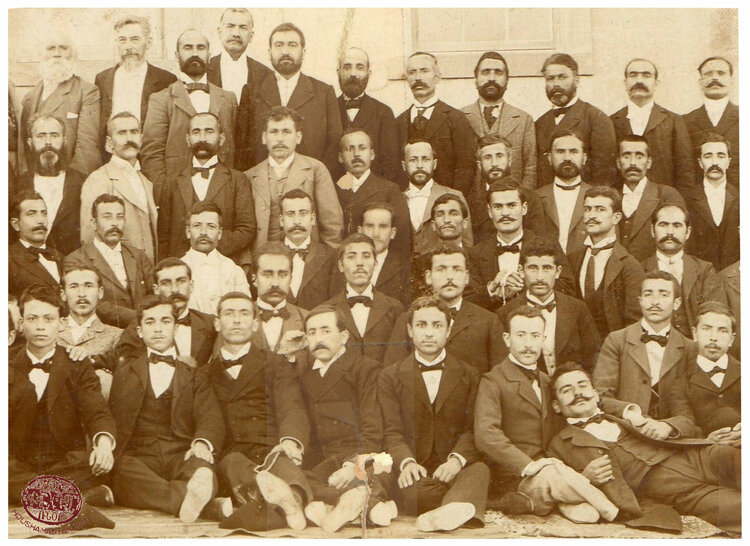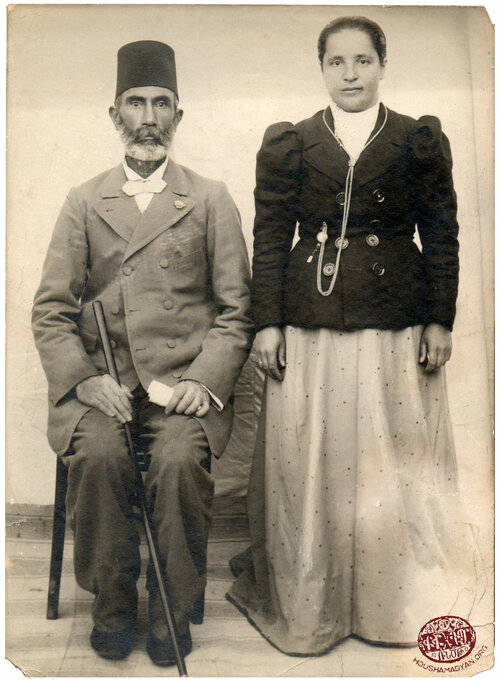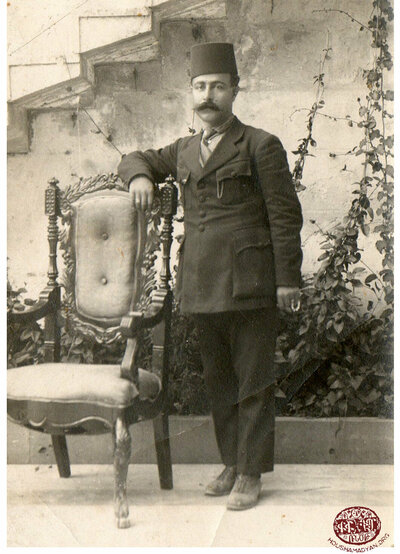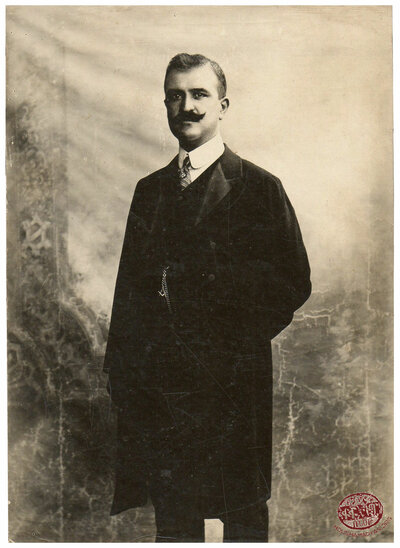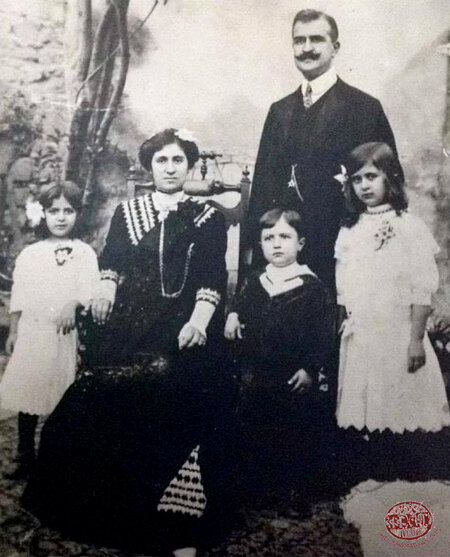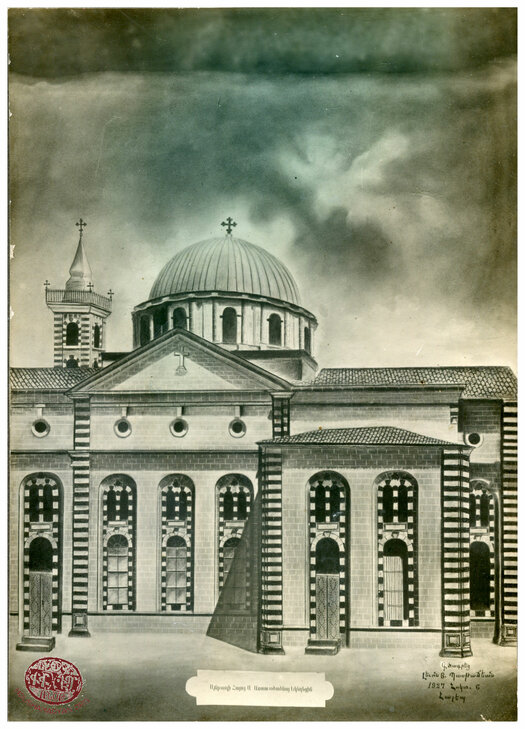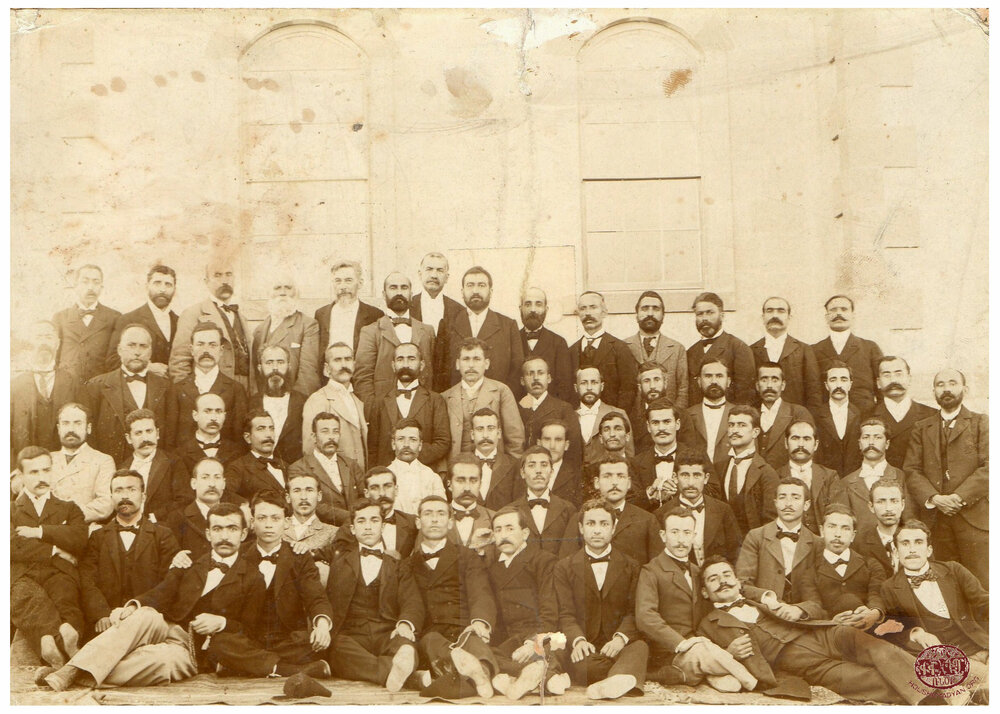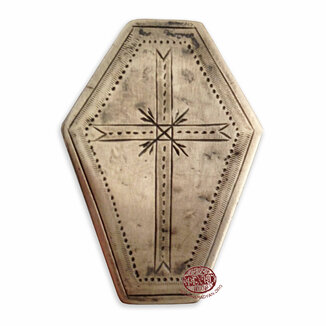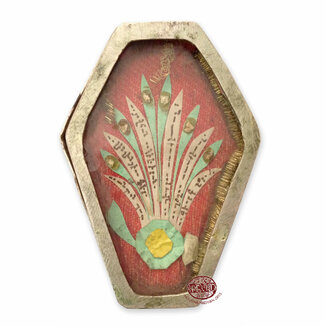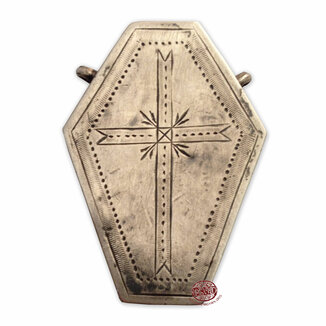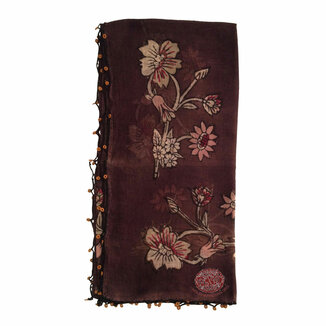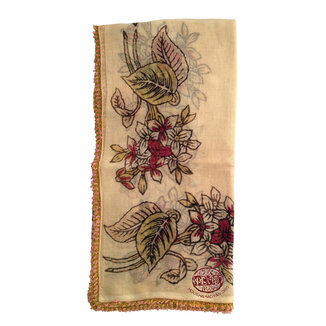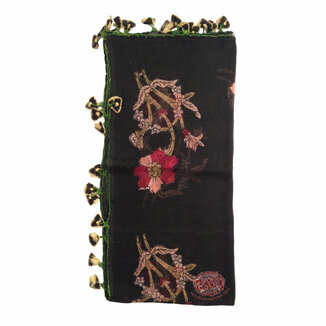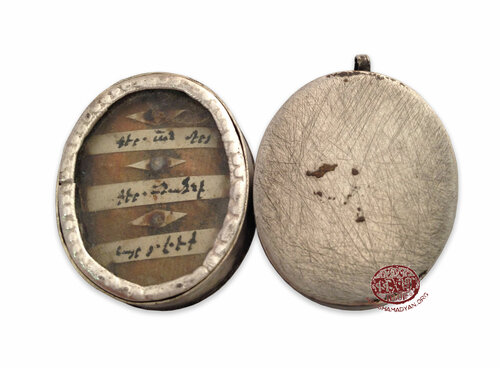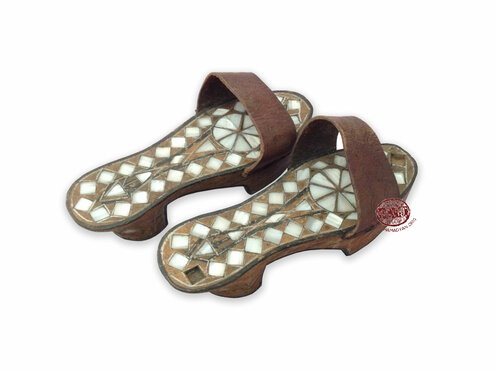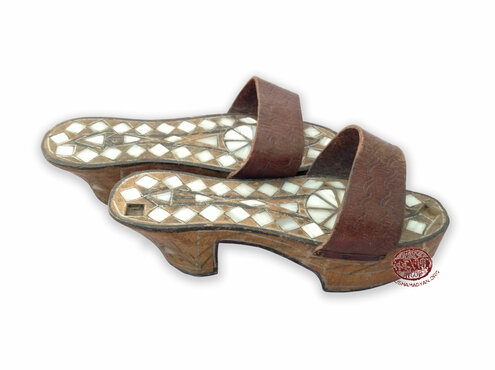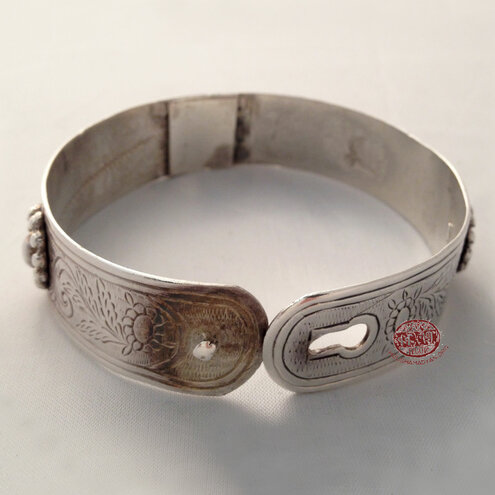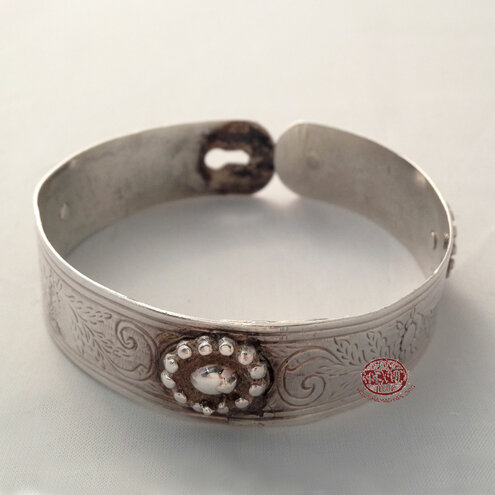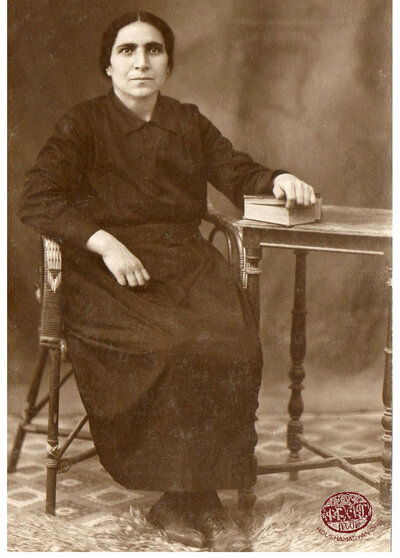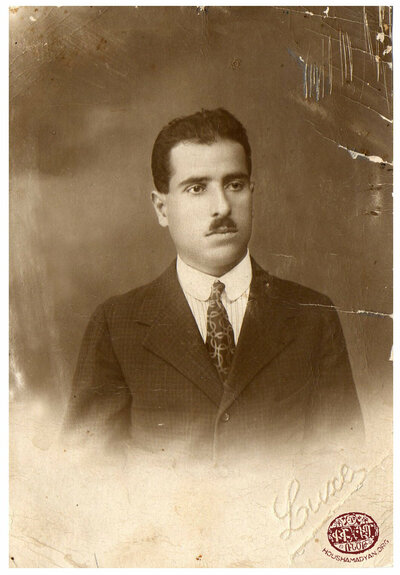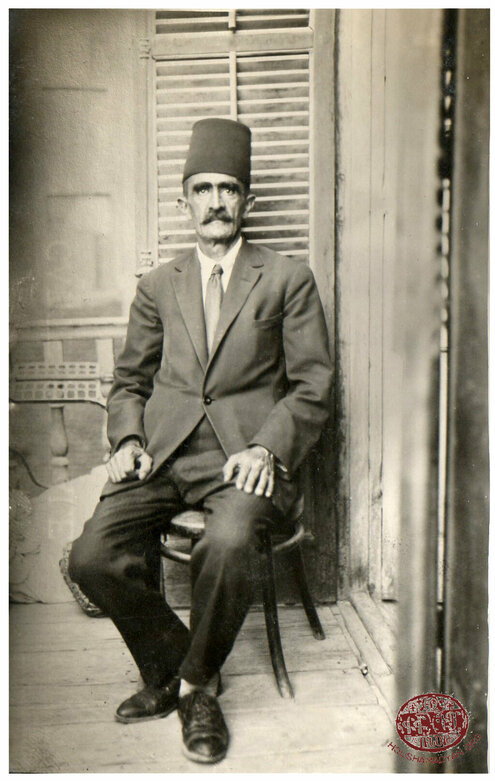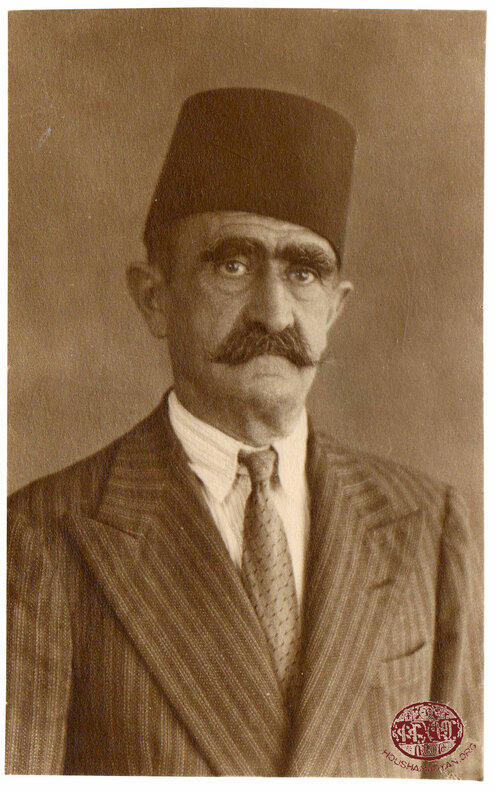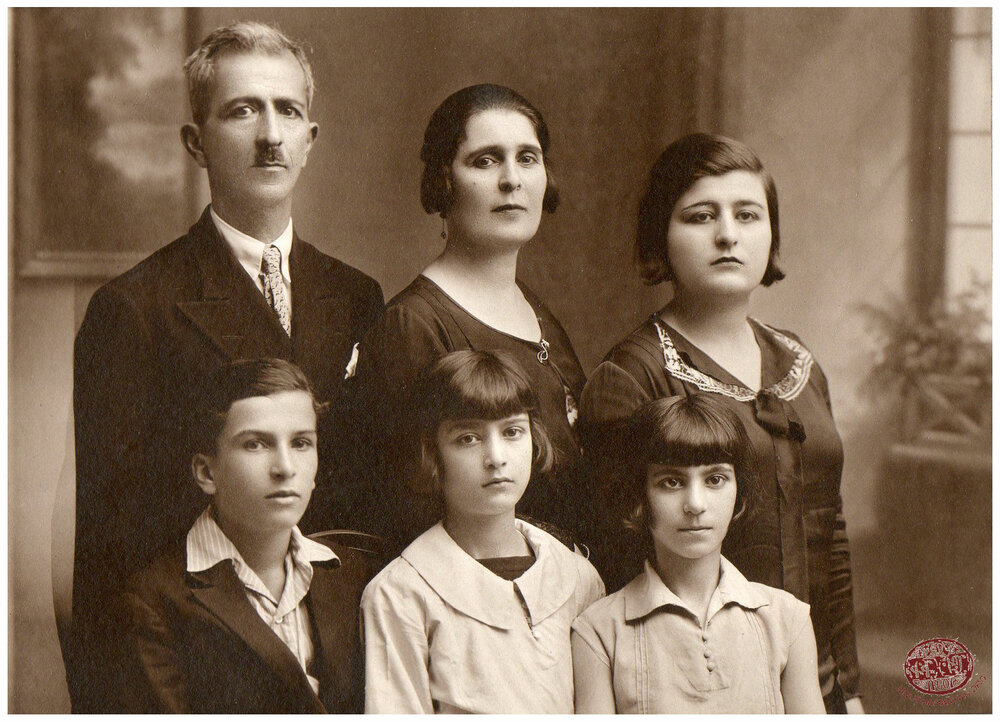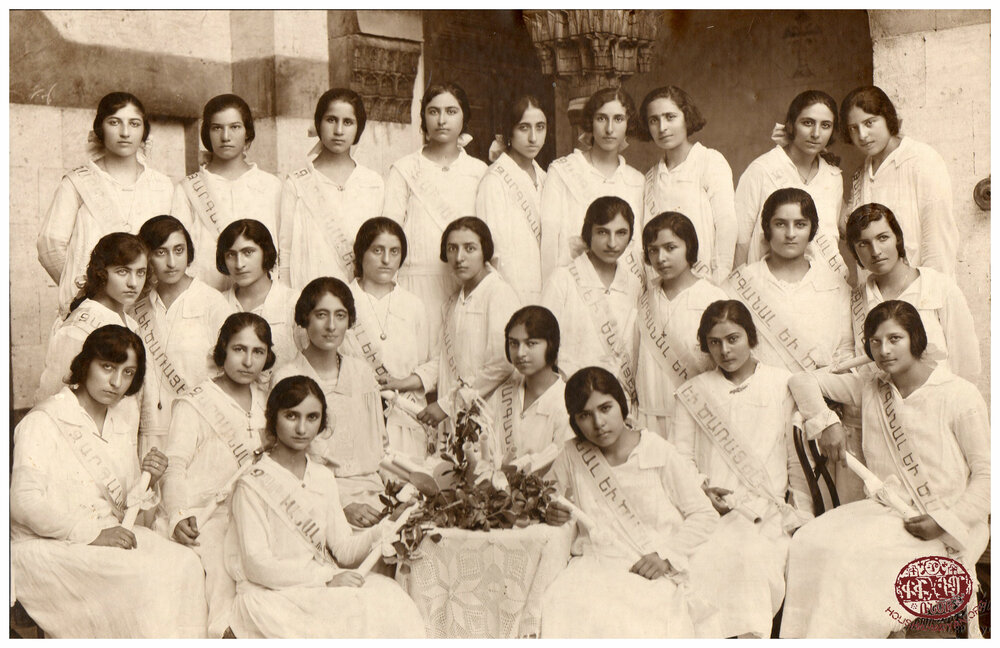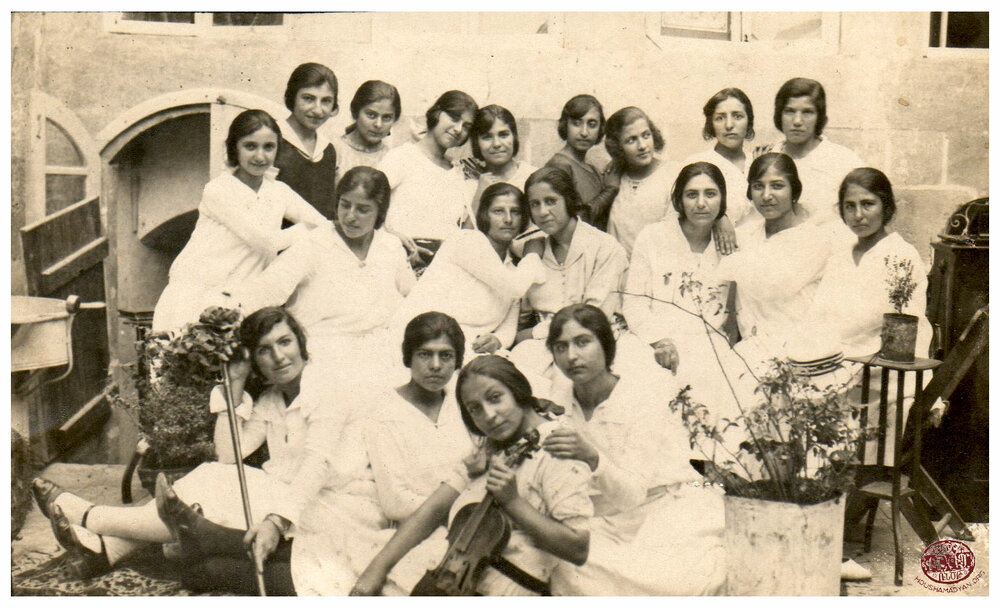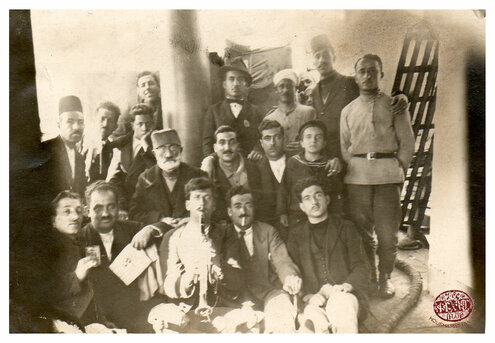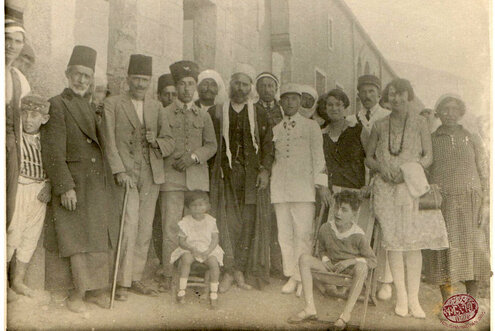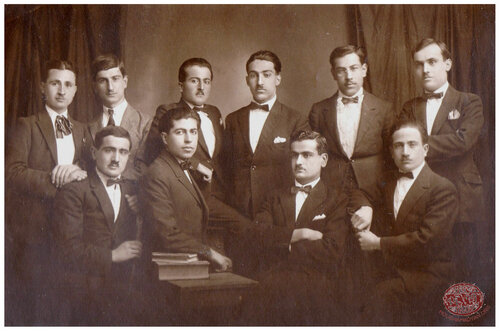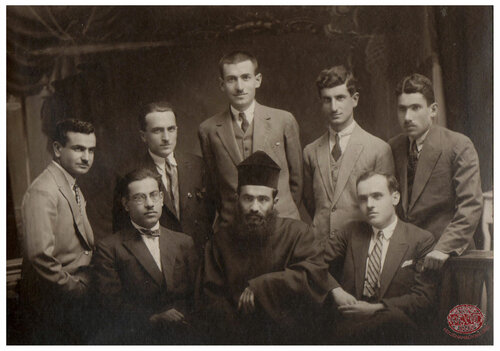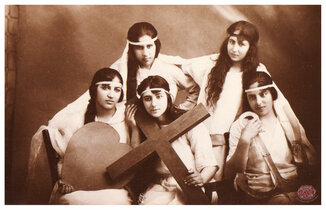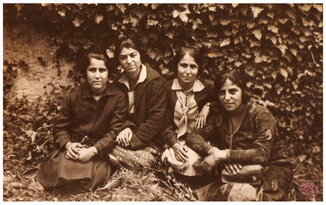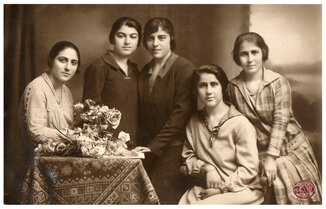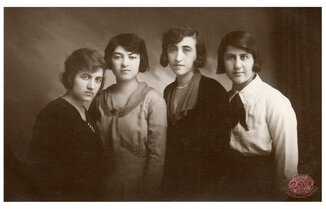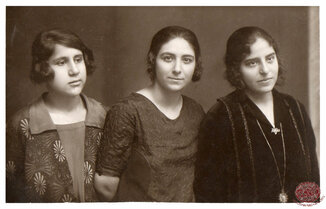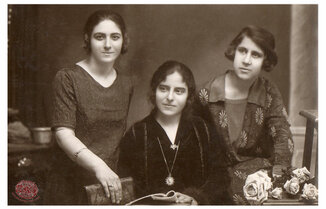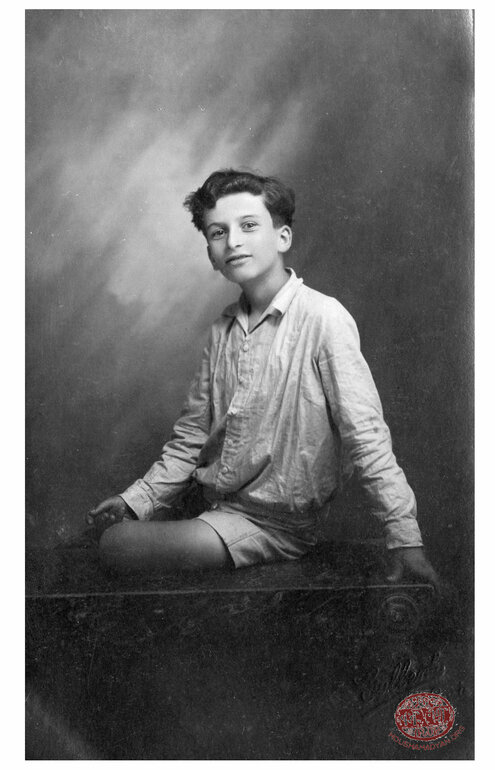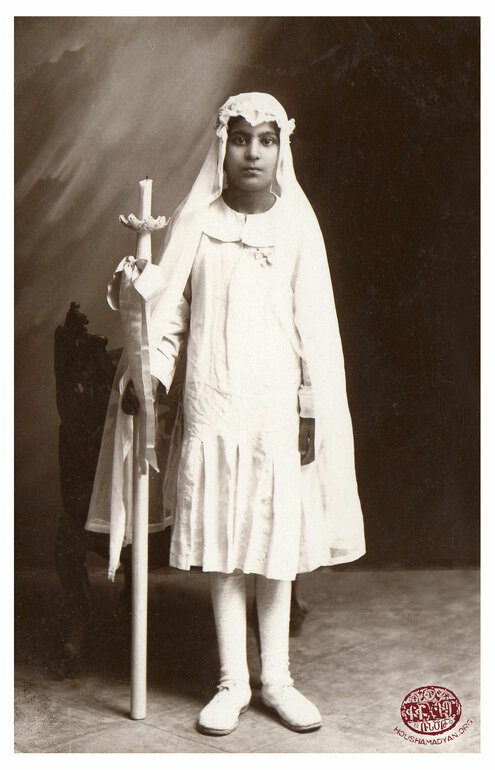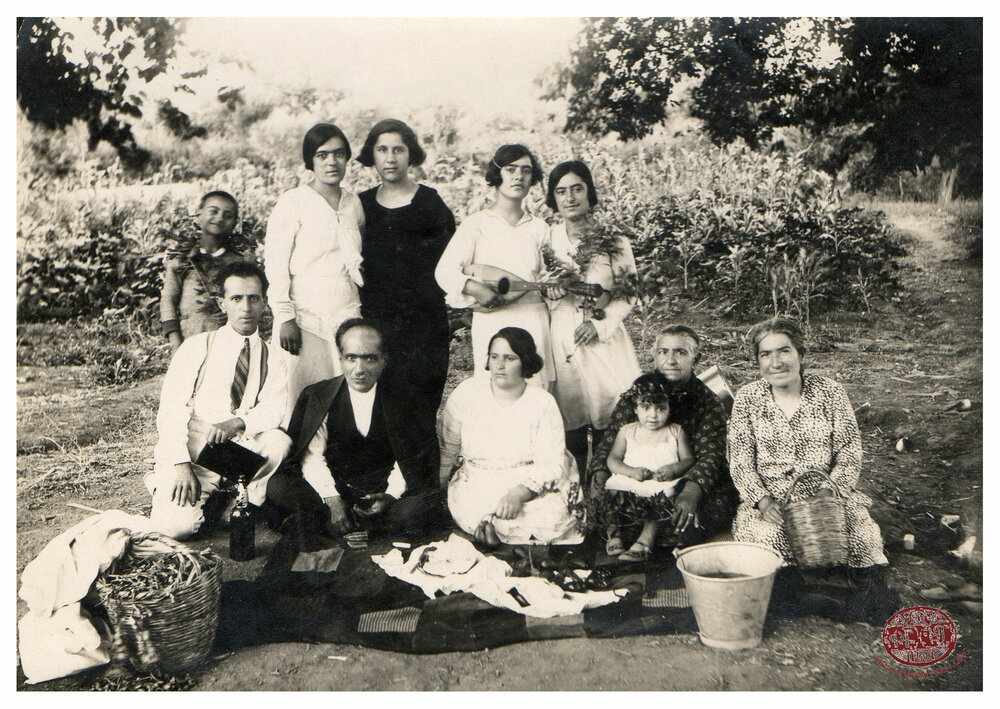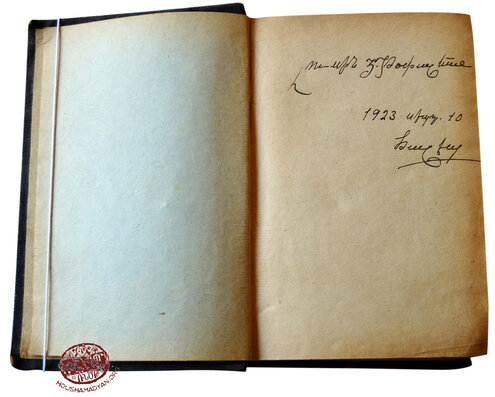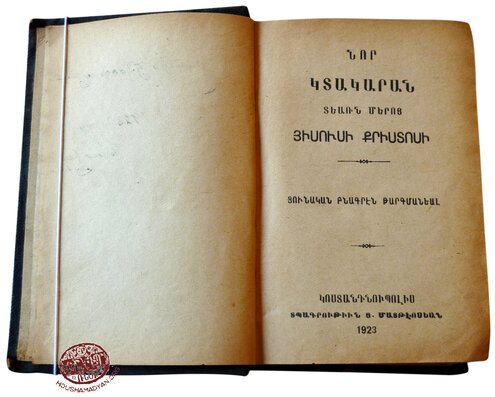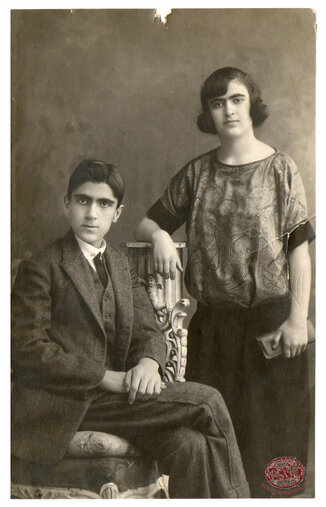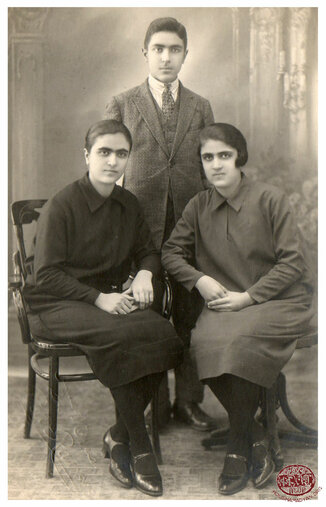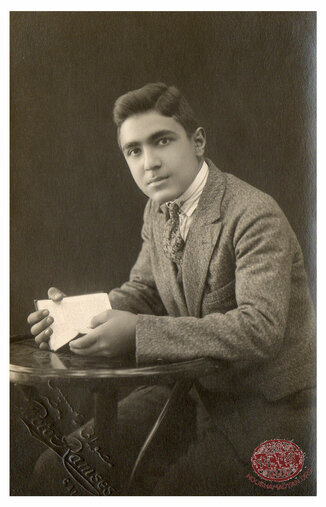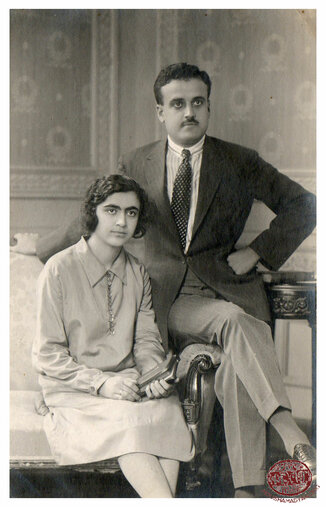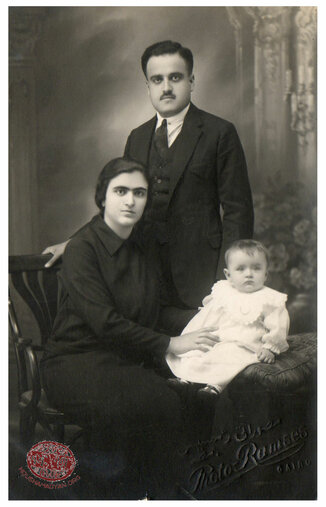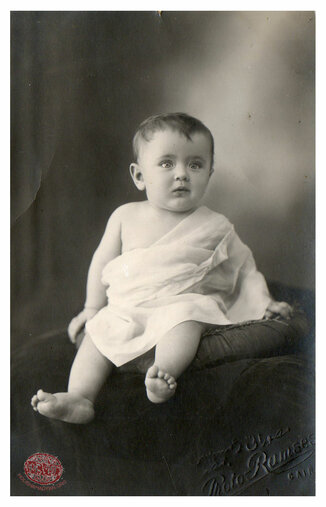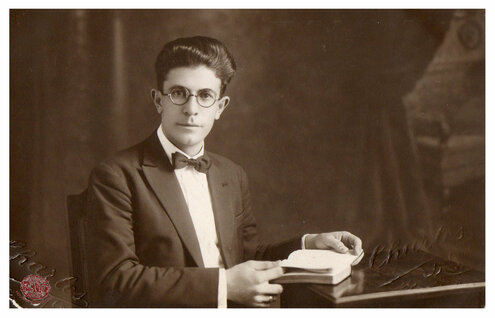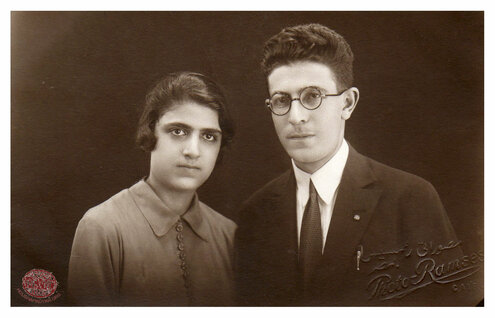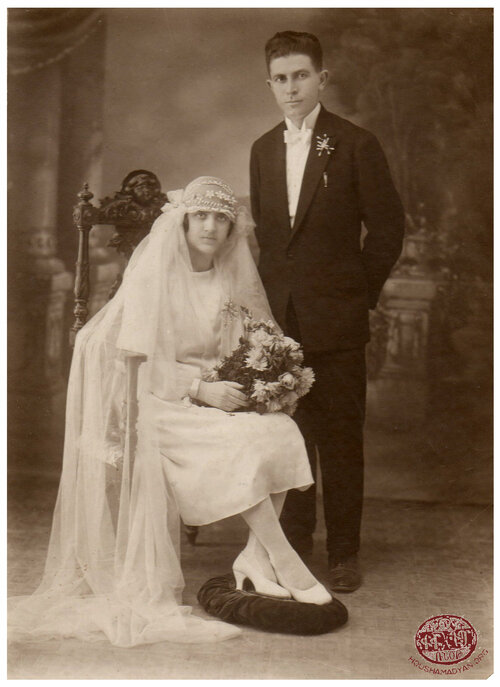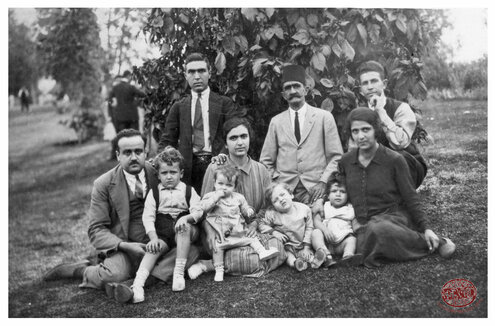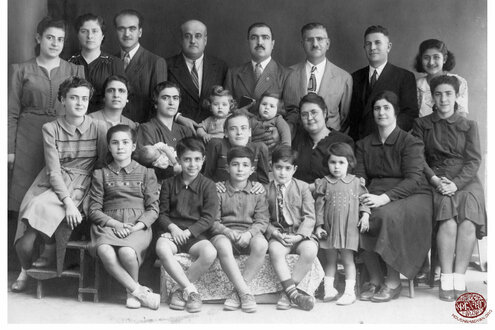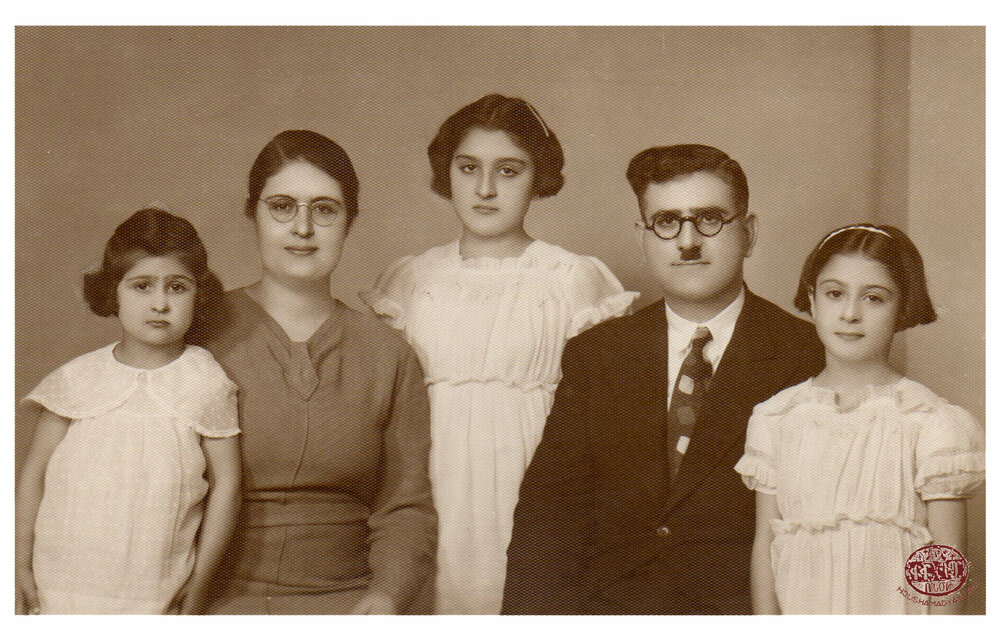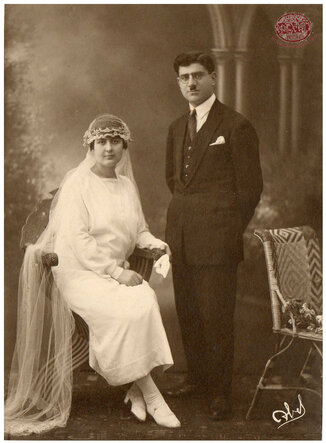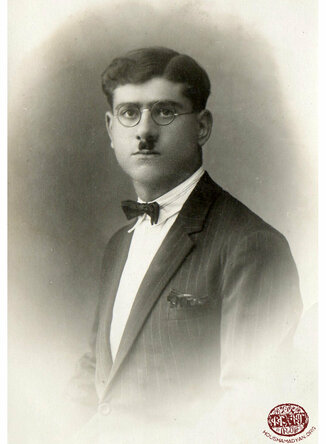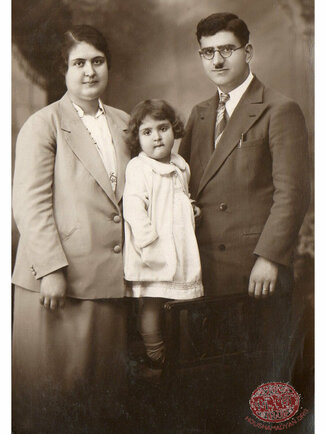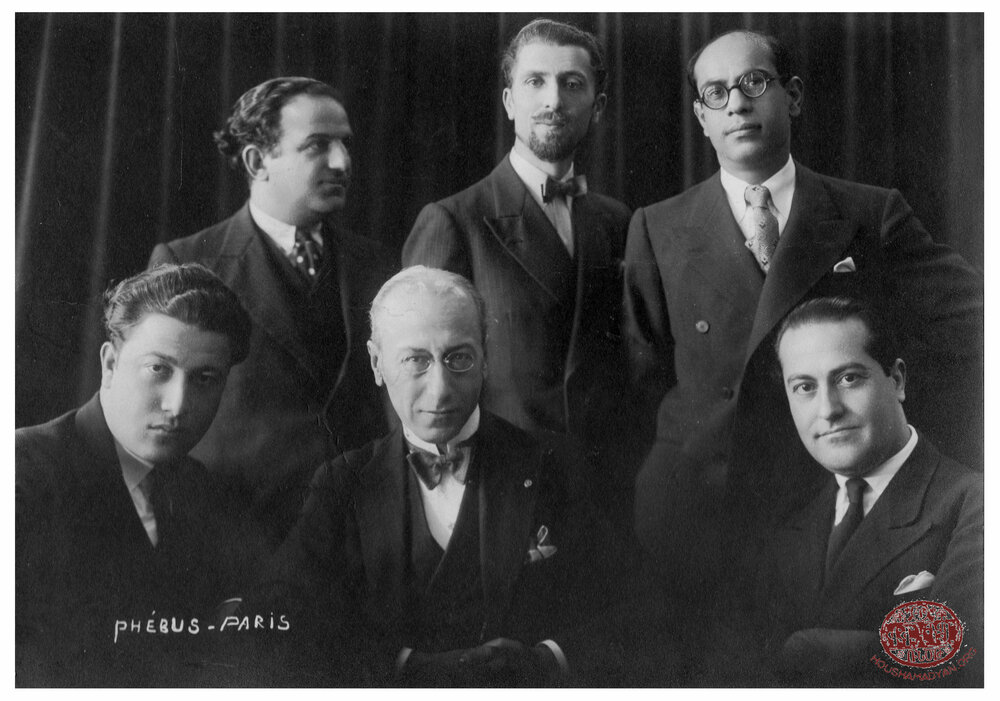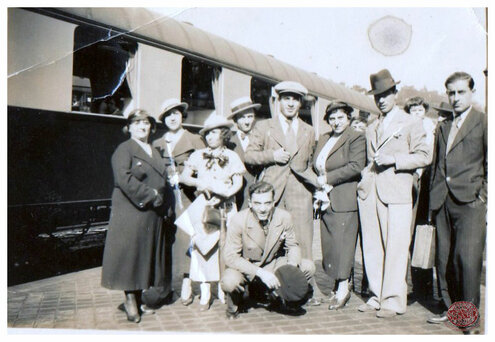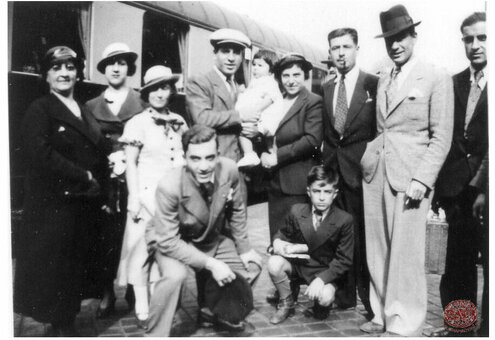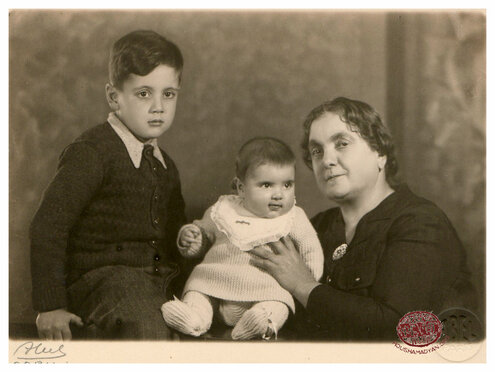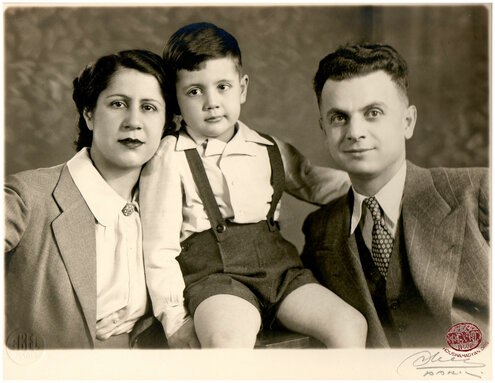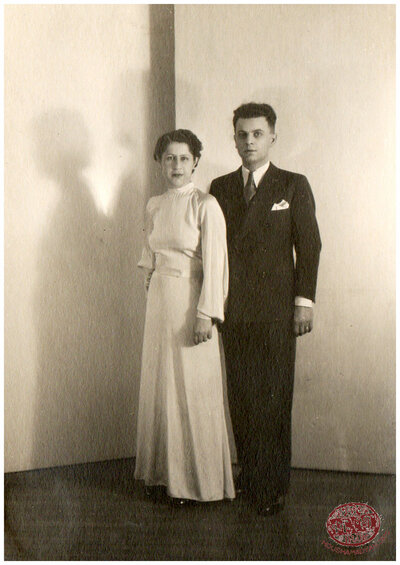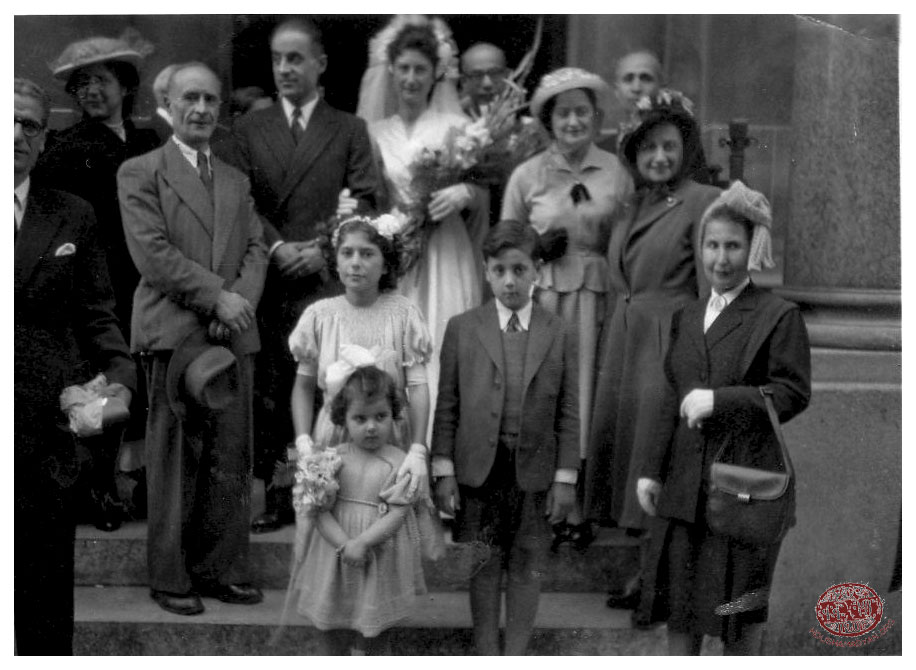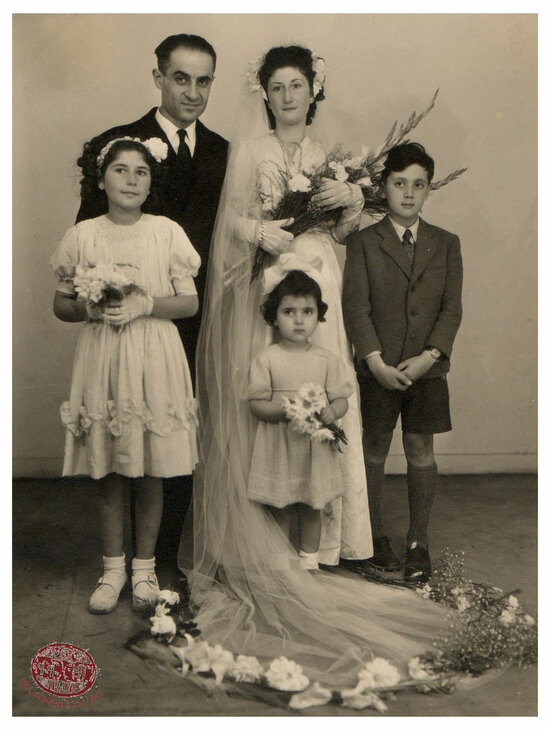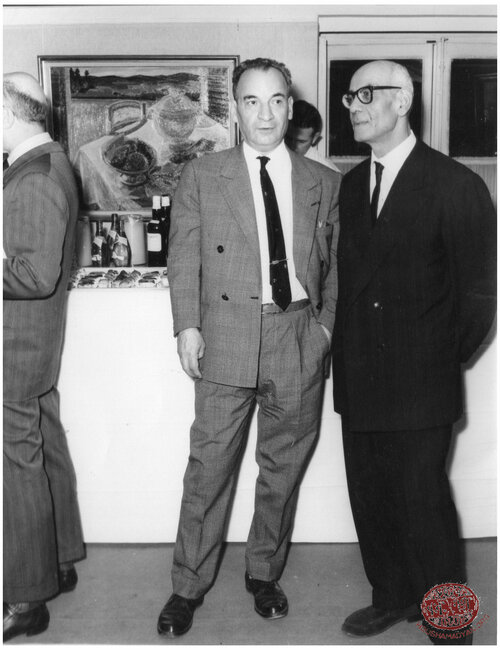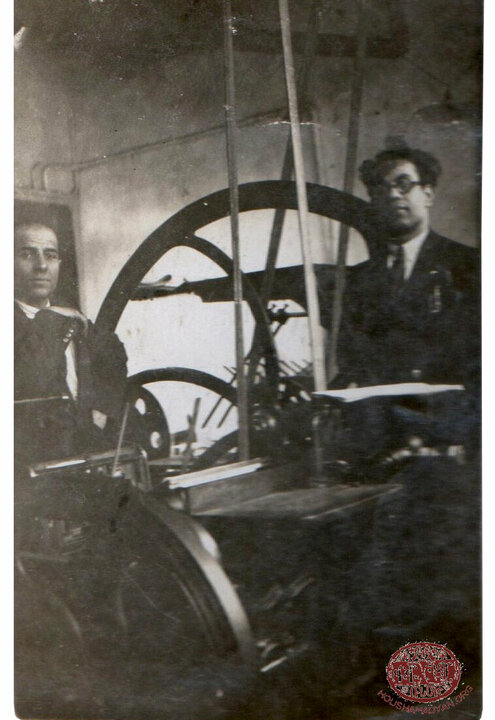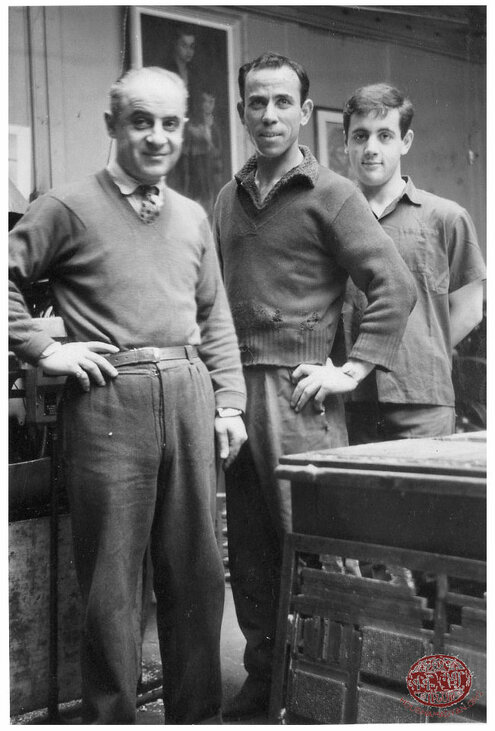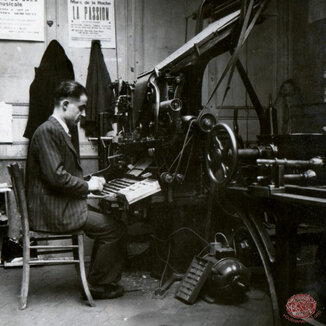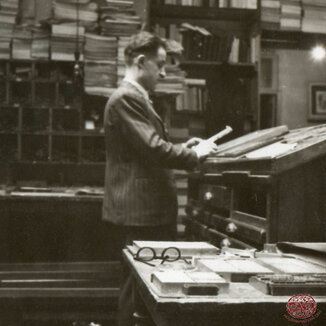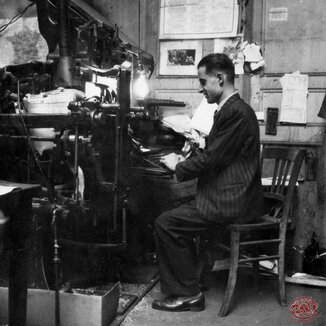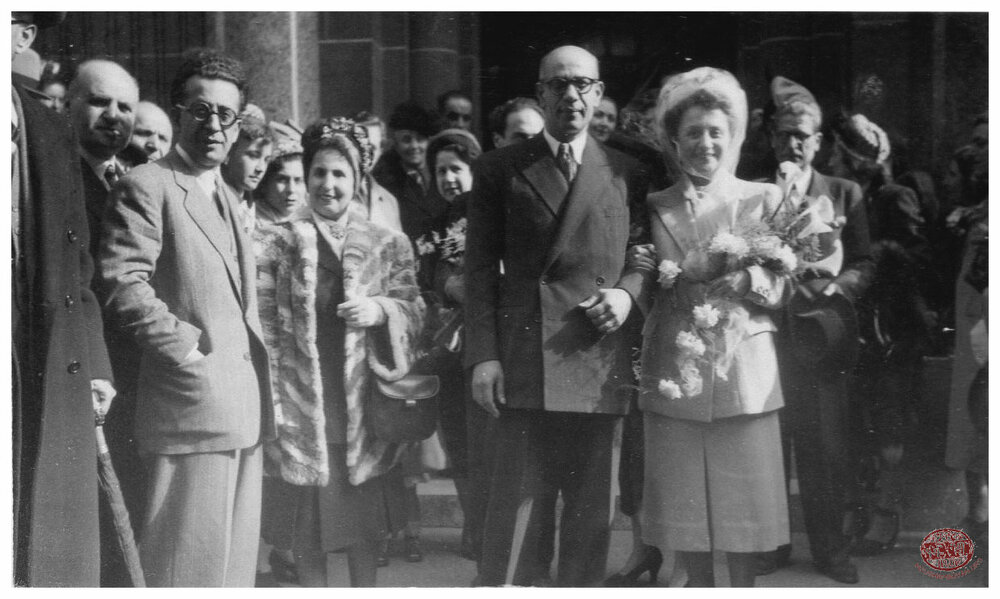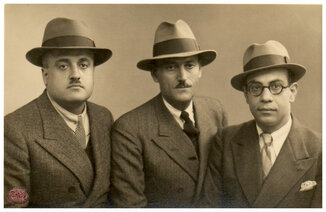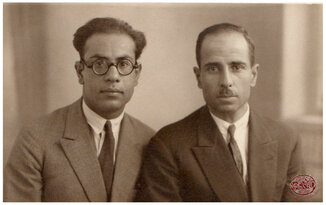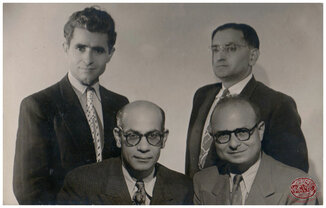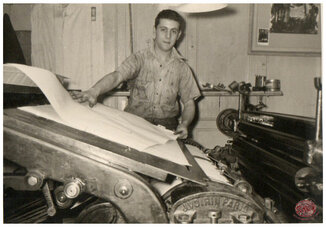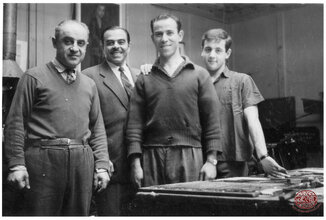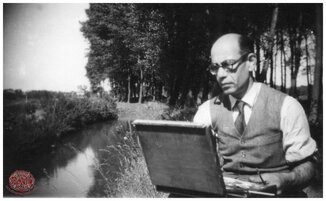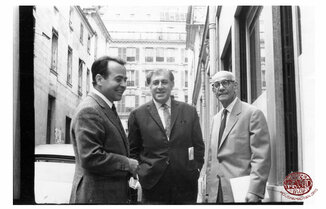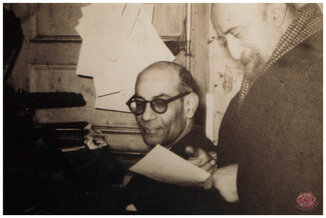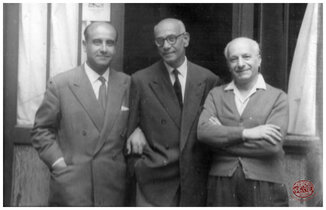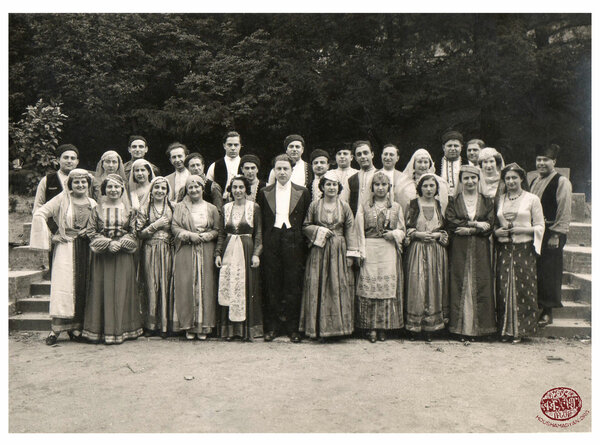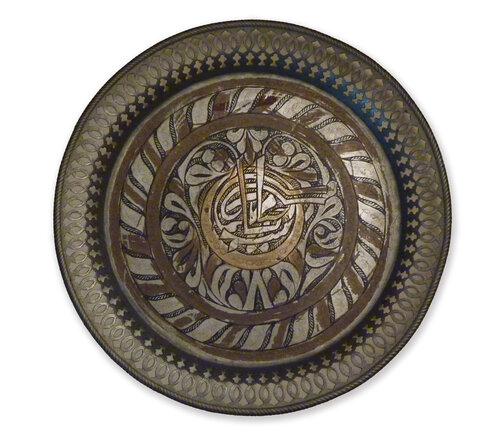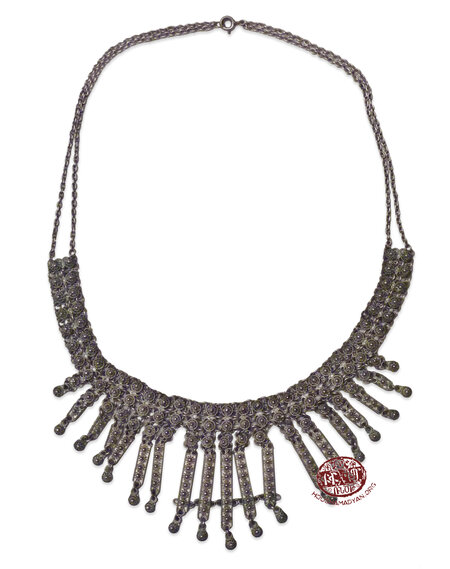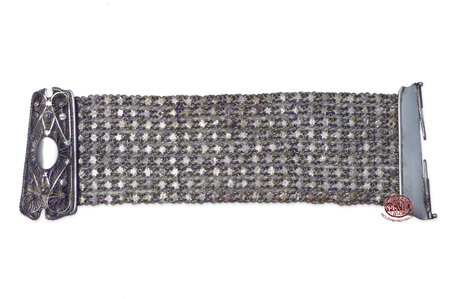Kambourian collection - Paris, France

This rich collection belongs to the Topalian family who originally hailed from Marash. The family later moved to Ayntab, and after the Genocide, the surviving members of the family settled in Aleppo. Henceforth, the family started spreading all over the world - Beirut, Cairo, Paris, Sao Paulo, and other places. Some of the objects and photographs are from Ayntab, Aleppo, Cairo and Paris while others are from Sölöz (Bursa vilayet) and belonged to Horop (Hripsime) Kambourian (born Yaghoubian).
These photographs and objects of memory were put at our disposal by Ani Kambourian (Paris), whose mother, Lousin, belongs to the Topalian family, while Lousin’s mother-in-law (Ani’s grandmother), Horop (Hripsime) Kambourian (born Yaghoubian) was born in Sölöz and some of the items in this collection belong to her. Ani Kambourian provided all the information concerning the photographs and memory objects.
The family history goes way back and one of the eldest members of the family whose identity we know is Hovhanness Efendi Topalian (1853-1932), who lived in Marash and was a member of the city’s court of justice. During a trial for a case concerning land ownership, his personal verdict against the Bayazid Zade famous family in Marash, makes him the target of some animosity, thus, in 1895, he and his family were forced to relocate to Ayntab. In Ayntab, Hovhanness became the advocate for the governmental tobacco management company (Régie des tabacs).
Hovhanness Topalian had 3 children from his first marriage: Diran, Vosgian and Yerchanig. After the death of his first wife, Margarit Bilezikdjian, who died very young, Hovhanness gets remarried with Santoukhd (Sanem) Keshishian, with whom he has 5 children: Puzant, Khosrov, Lousin, Noubar and Hampartsoum.

Ayntab years

We don’t know much about the life that the Topalians led in Ayntab; we only know that the Topalian children attended school there. Puzant (1902-1970) attended the local Nersesian School, while Vosgian Topalian is a graduate from the Central Turkey College (the Ayntab college).
During the Genocide, the Topalian family, just like most of the Armenians in Ayntab, were exiled and sent towards Aleppo. While Vosgian Topalian was killed in Erzincan/Yerzenga, the rest of the Topalians survived and managed to settle in Aleppo and stayed there till the end of the war.
After the ceasefire, when repatriation back to Cilicia was organized for the survivors who were exiled, the Topalian family also returned to Ayntab and stayed there till 1922. During this time, Puzant Topalian continued to pursue his education at the Ayntab College. With his friends Avedis Der Sahagian and Antranig Bulbulian (later priest Der Karekin), Puzant published the collagraph print newspaper “Dzaghig”, which had three issues; at the same time, Puzant owned a small stationary shop.

Vosgian Topalian is Hovhanness’s son from his first marriage. Vosgian was born in Marash in 1878. After surviving the massacres in Marash, in 1895 the Topalian family moved to Ayntab. Vosgian attended the Central Turkey College (the Ayntab college) and graduated in 1898. Later, he graduated from the Faculty of Medicine of the American University of Beirut in 1905. He married Shamiram Pirinchian and they had three children: Eftimia, Veronica and Garabed. He later settled in Diyarbekir/Dikranagerd where he opened his own private practice and worked as a surgeon. His clinic had the first radiology machine in Turkey (he had been trained as a medical radiographer in England). He became the interpreter for the British Embassy. During WWI, he was enlisted as a military doctor, with a captain’s rank, at the Aziziya Hospital in Erzurum. In June 1915, he was killed by Turkish soldiers in Yerznga (Erzincan), at the same time as the other Armenian doctors. During the deportations, Shamiram, Veronica and Garabed were executed. Vosgian’s eldest daughter Eftimia was the only survivor of the family. These two photographs are of Vosgian Topalian, in the photo on the left, he is photographed wearing the ottoman army attire.


The date in brackets is the graduation year of the alumnus. No date means the person is not a graduate of Central Turkey College.
Front row, seated from left to right are: Levon S. Sivaslian (1901), Garabed H. Khalfeyan (1901), Nazareth S. Barsoumian (1901), Haroutyoun Der Boghossian (1901), Dajad D. Dakessian (1901), Jorji (George) Poladian (1901), Haroutyoun Zernikian (1900), Senekerim Niziblian (1899), Yakoub G. Mouradian (1901) and Isaiah (Yesayi) Halladjian (1901).
Second row, seated from left to right are: Hagop Ghazarian (1899), Apraham Haroutyounian (1899), Jirjis (George) Shemmas (1899), Mihran Nazaretian (1899), Yousif Niziblian (1899), Apraham Seraidarian (1899), Vahan Guldalian (1899), Yeghia Demirjian (1900), Asadour Jinishian (1900), Haroutyoun Berdjiklian (1900) and Garabed Moughamian (1900).
Third row, seated from left to right are: Professor Nishan S. Baliozian (1892), Mr. Haroutyoun Mouradian (1893), Zakaria Bedrossian (1894), Yeghia Kassouni, Sdepan A. Tovmassian (1897), Setrak (Varjabedian) Vazhabedian (1895), Hagop (Kalemkerian) Kalemjian (1896), Hovhannes Moushegh Hadidian (1896), Dikran Poladian (1896), Mr. Yakoub Der Krikorian (1897), Vosgan Topalian (1898) [wearing a bow tie, sitting slightly turned, with a slightly high collar], Vartan Yeranian (1898) and Mourad Adonian (1898).
Fourth row, standing from left to right - only three persons have been identified from the 15 who are standing: first from left is Professor Zenope A. Bezjian (1880), first from right is Professor Sarkis Levonian (Marash Theological Seminary) and second from right is Professor Hovhannes K. Krikorian (Marash Theological Seminary). We also know the names of other nine people who are standing in the fourth row without identifying them: Movses Bezjian (1887), Movses Ashdjian (1887), Krikor Kurkyasharian (1889), Levon Soghovmeyan (1889), Haroutyoun Hagop Khalfeyan (1890), Nazaret Heghinian (1890), Garabed Haroutyounian (1890), Nerses Baghdoyan (1891) and Yakoub Dasho (1891).
Back row, standing from left to right are: Hovhannes Jemelian (1880), Aram Assadour Altounian (1881), Baghdasar Barsoumian (1881), Professor Alexan Bezjian (Bebek Seminary), President Rev. Americus Fuller, Professor Manasseh G. Papazian (1882), Kalousd Najarian (1882 and 1888 - Medicine Department), Hovsep K. Bezjian (1882), Manoug Missirian (1882), Krikor Karayian, Nerses Levonian (1882), Sdepan Hovhannessian (1882), Hamparzoum Ashjian (1884) and Sarkis Hagopian (1884).

This silver prayer box (length: 4.5 cm) belonged to Ani Kambourian’s paternal grandmother, Horop (Hripsime) Kambourian (born Yaghoubian). This object was surely revered as having protective powers for the family. Family members probably wore it around their necks, or kept it under their pillows. The names of six saints are written in the box; the first two of those are illegible, the others are: Hovhan Vosgeperan, Bedros Arakyal, Boghos Arakyal and Kevork Zoravar.
The Prayer box is from Sölöz (Bursa vilayet) and is currently in the possession of Ani Kambourian in Paris.



Post-Genocide years: Aleppo

After the Genocide, the Topalian family, or rather those who survived, started building a new life in Aleppo. Armenians from Ayntab made up the majority of Armenian refugees from all over the Ottoman Empire who had arrived to Aleppo. Thus, it was not surprising that often the Topalian family members’ colleagues and classmates were also fellow refugee Armenians from Ayntab.
After settling in Aleppo, Puzant Topalian started working at the “Joseph Ajemi” publishing house. After acquiring some experience in the field, Puzant bought a small printing machine and with a friend from Ayntab, Avedis Der Sahagian, they rented a small shop and turned it into a printing house. During these years, Puzant worked as a typographer for the “Souriagan Mamoul [Syrian Press]” newspaper. He published the collagraph print newspaper “Meghou” with his friends, which had seven issues and was published from 1923 to 1925.
In 1925, Puzant and his brother Hampartsoum founded the “Arax” publishing house; many books, monthly newspapers and yearbooks were published in Armenian, English, French and Turkish written in Armenian letters. In 1926, Puzant became the director of the “Datev” yearbook, while its editor was the prelate of Aleppo, Archbishop Ardavazt Surmeian.




The female graduates of the Armenian national mixed-gender school (later called the National Haigazian school), photographed here with their school directress, on the occasion of receiving their end-of-year diplomas for the academic year 1923-1924. The ribbons the girls are wearing have the following written on them: “zarkanal yev dzarayel” in Armenian (meaning “to progress and to serve”). The photographer is Derounian.
First row, seated from left to right are: Lousin Ekmekjian, Alice Davoyian, Anahid Euleubeyian, Hranoush Tahtajian (later Benlian, she becomes the director), Anahid Aleksanian, Azniv Vosgerichian, Valentine Rakejian, (identity unknown).
Second row, from left to right are: Mariam Tavoukjian, Zabel Mouradian, Asdghig Tufenkjian, Azniv Shim Shimshirian, Never Yousoufian, (identity unknown), Arshalouys Chakmakjian, Makrouhi Abajian, Meline Bayramian.
Third row (the highest row), from left to right are: Vartiter Pierian, Mary Panosian, Lousin Topalian, (identity unknown), Araksi Babignian, Vergine Bayramian, Dirouhi Keorhajian, (identity unknown), Azniv Andelian.

1) Khosrov Topalian photographed on the Transméditerranée boat, while on his way to Istanbul. Most probably photographed in the beginning of the 1920’s. Khosrov is seating in the second row, he is the second from the right (there is a small child standing next to him on the right). Khosrov was the first from the Topalian family who settled in France. After Istanbul, Khosrov probably continued his journey to France.
2) This photograph was found in Noubar Topalian’s collection. The explanation on the back says Khiam, which is probably somewhere in the vicinity of Aleppo. The photograph was taken on the 29th of September 1928. We can see soldiers serving in the French army, local Arabs and others in the photo.


1) Most probably photographed in Aleppo, also possible for the photo to be taken in Ayntab. Standing from left to right are: Lousin Topalian, Alice Davoyian. Seated to the far right is Azniv Andelian.
2) Aleppo, around 1925. From left to right are: Lousin Topalian, (identity unknown), Alice Davoyian, Azniv Andelian.
3) Aleppo, around 1924. Seated on the right is Lousin Topalian, to her left is Azniv Andelian while to her right is Alice Davoyian. The identities of the others in the photograph are unknown.
4) Aleppo, around 1924. To the far right is Lousin Topalian. The identities of the others in the photograph are unknown.
5) Aleppo, around 1925. On the left is Lousin Topalian, the identity of the person in the center is unknown, and on the right is Azniv Andelian.
6) Aleppo, around 1925. The identity of the person on the left is unknown, in the center is Azniv Andelian, and on the right is Lousin Topalian.


Cairo

Hovhanness Topalian’s son, Diran Topalian and his family settled in Cairo after passing through Aleppo where they lived for a while after being exiled from their native Ayntab. Diran was married to Nazenig and they had four children together: Zabel, Kegham, Keghanoush and Garabed.
1) Kegham and Zabel Topalian.
2) From left to right: Zabel, Garabed (standing) and Keghanoush photographed in Cairo.
3) Garabed Topalian. The photo is by: Photo Ramses, Cairo.
4) Zabel (born Topalian) and her husband Hovhanness Boyadjian in Cairo.
5) Zabel (born Topalian) and her husband Hovhanness Boyadjian, with their newborn son, Vahe.
6) Vahe Boyadjian – Zabel and Hovhaness; son. The photo is by: Photo Ramses, Cairo.




Beirut

Vosgian Topalian’s daughter, Eftimia, is the family member who settled in Beirut. She was married to Garabed Merjanian.

Paris

Khosrov Topalian had already settled in Paris when his brothers Puzant and Hampartsoum left Aleppo and joined him in France. Together, the three brothers founded the “Arax” printing house, which would later become an important meeting point for the Armenian intellectuals in Paris. The literary group “Menk”’s eponymous first review was printed by the “Arax” printing house in 1931.
In 1932, Hovhanness and Santoukhd Topalian had already passed away in Aleppo, and their son Noubar had also died, thus, Lousin Topalian also left Aleppo and resettled in Paris.
Besides his work in the printing house, Puzant also published poetry volumes in Paris, and edited the “Antasdan” literary-artistic periodical book. He was also a painter.
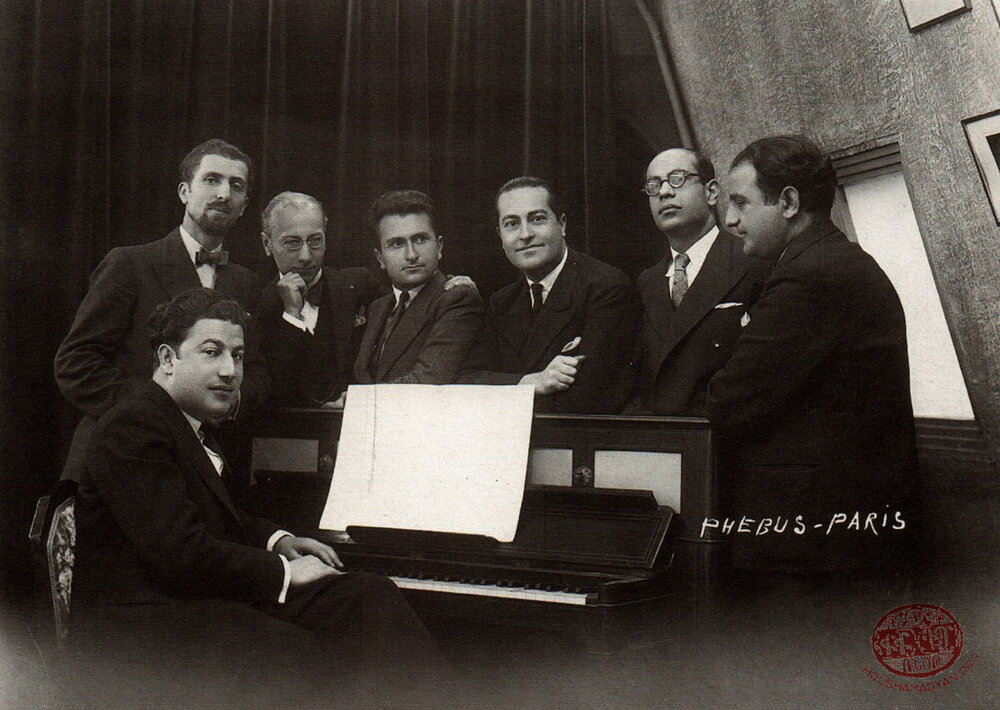
Meeting in the attic of Phébus studio, 23 bd Bonne Nouvelle, Paris, 1935. At the piano, the composer Kourken Alemshah. From left to right, Noubar Arabian, the painter Hrant Alyanak, Phébus (Hagop Semerdjian) himself, Philip Aghazarian, the poet Puzant Topalian and Kegham Kerestedjian.


1) Paris, from left to right are: Toros Kambourian, Ani Kambourian and Hripsime Kambourian. Ani and Toros are Lousin Kambourian’s (born Topalian) children. Hripsime is Lousin’s mother-in-law, who was born in Sölöz.
2) Paris, 1944. From left to right are: Lousin (born Topalian), Toros and Ghazaros Kambourian (Lousin’s husband).





1) From left to right: Hohanness Boyajian, Khosrov Topalian and Puzant Topalian.
2) Paris, 1930. The brothers Puzant (on the left) and Khosrov (on the right) Topalian.
3) Standing, from left to right are: Vahe Vahian and Yervant Armadouni. Seated from left to right are: Puzant Topalian and Zareh Vorpouni.
4) At the “Arax” printing house. Toros Kambourian (Lousin Topalian’s son) at work.
5) At the “Arax” printing house. From left to right are: Hampartsoum Topalian, Dev, Garbis and Toros Kambourian.
6) Puzant Topalian while painting.
7) Paris, around 1968. From left to right are: Richard Geranian, Vahram Mavian and Puzant Topalian.
8) At the “Arax” printing house. Puzant Topalian on the left and Arshag Chobanian on the right.
9) Paris, 1959. From left to right are: Vartan Gomigian, Puzant Topalian and Hrant Palouian.


